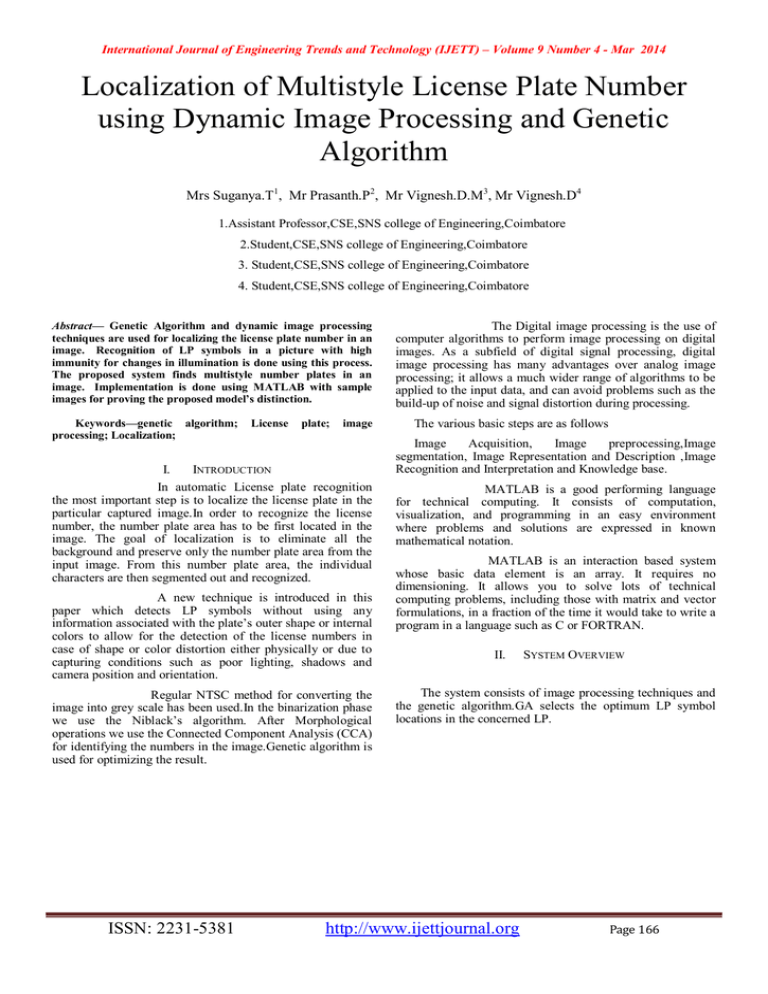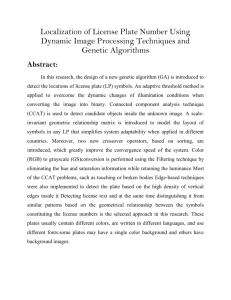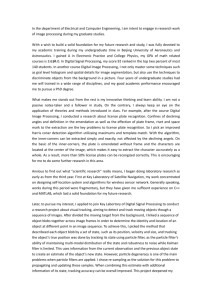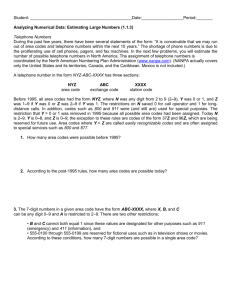Localization of Multistyle License Plate Number Algorithm Mrs Suganya.T
advertisement

International Journal of Engineering Trends and Technology (IJETT) – Volume 9 Number 4 - Mar 2014 Localization of Multistyle License Plate Number using Dynamic Image Processing and Genetic Algorithm Mrs Suganya.T1, Mr Prasanth.P2, Mr Vignesh.D.M3, Mr Vignesh.D4 1.Assistant Professor,CSE,SNS college of Engineering,Coimbatore 2.Student,CSE,SNS college of Engineering,Coimbatore 3. Student,CSE,SNS college of Engineering,Coimbatore 4. Student,CSE,SNS college of Engineering,Coimbatore Abstract— Genetic Algorithm and dynamic image processing techniques are used for localizing the license plate number in an image. Recognition of LP symbols in a picture with high immunity for changes in illumination is done using this process. The proposed system finds multistyle number plates in an image. Implementation is done using MATLAB with sample images for proving the proposed model’s distinction. Keywords—genetic algorithm; processing; Localization; License plate; image I. INTRODUCTION In automatic License plate recognition the most important step is to localize the license plate in the particular captured image.In order to recognize the license number, the number plate area has to be first located in the image. The goal of localization is to eliminate all the background and preserve only the number plate area from the input image. From this number plate area, the individual characters are then segmented out and recognized. A new technique is introduced in this paper which detects LP symbols without using any information associated with the plate’s outer shape or internal colors to allow for the detection of the license numbers in case of shape or color distortion either physically or due to capturing conditions such as poor lighting, shadows and camera position and orientation. Regular NTSC method for converting the image into grey scale has been used.In the binarization phase we use the Niblack’s algorithm. After Morphological operations we use the Connected Component Analysis (CCA) for identifying the numbers in the image.Genetic algorithm is used for optimizing the result. ISSN: 2231-5381 The Digital image processing is the use of computer algorithms to perform image processing on digital images. As a subfield of digital signal processing, digital image processing has many advantages over analog image processing; it allows a much wider range of algorithms to be applied to the input data, and can avoid problems such as the build-up of noise and signal distortion during processing. The various basic steps are as follows Image Acquisition, Image preprocessing,Image segmentation, Image Representation and Description ,Image Recognition and Interpretation and Knowledge base. MATLAB is a good performing language for technical computing. It consists of computation, visualization, and programming in an easy environment where problems and solutions are expressed in known mathematical notation. MATLAB is an interaction based system whose basic data element is an array. It requires no dimensioning. It allows you to solve lots of technical computing problems, including those with matrix and vector formulations, in a fraction of the time it would take to write a program in a language such as C or FORTRAN. II. SYSTEM OVERVIEW The system consists of image processing techniques and the genetic algorithm.GA selects the optimum LP symbol locations in the concerned LP. http://www.ijettjournal.org Page 166 International Journal of Engineering Trends and Technology (IJETT) – Volume 9 Number 4 - Mar 2014 environment around it resulting in several illumination problems. Hence binarization of the image according to a fixed global threshold is not suitable to overcome these problems. IN our system Niblack’s algorithm is used for it provides better results than other algorithms(reference: A Feature Based Approach for Localization of Indian Number Plates Prathamesh Kulkarni (Student Member, IEEE)) The output of Niblack's method is significant and has most acceptable result out of all thresholding techniques in segmenting text documents. Color to Greyscale conversion The input image is captured as a color image taking into account further processing of the image to extract other information relevant to the concerned vehicle. Color (RGB) to grayscale (gs) conversion is performed using the standard NTSC method by eliminating the hue and saturation information while retaining the luminance as follows: Y=0.299*R+0.587*G+0.114* The given coefficients represent the measured intensity perception of an average trichromat humans. In particular, human vision is most sensitive to green and least sensitive to blue. To encode grayscale intensity in linear RGB, each of the three primaries can be set to equal the calculated linear luminance Y (replacing R,G,B by Y,Y,Y to get this linear grayscale). A. Adaptive Binarization Converting the input image into a binary image is one of the most sensitive stages in localizing LPs due to spatial and temporal variations encountered in the plate itself and the ISSN: 2231-5381 B. Morphological Operations Morphological operations such as dilation and erosion are important processes needed for most pattern recognition systems to eliminate noisy objects and retain only objects expected to represent the targeted patterns. In LP detection, closing operation (dilation followed by erosion) is performed to fill noisy holes inside candidate objects and to connect broken symbols. On the other hand, opening (erosion followed by dilation) is applied to remove objects that are thinner than the LP symbols. In our system, closing is applied to fill spaces that break the bodies of symbols using a 3-pixel-disk element in the first experiment. This process is very important especially for the recent Saudi LP layout where a light gray watermark is used for authentication purposes. This watermark becomes white after the binarization process and breaks down most of the bodies of the LP symbols. C. Connected Component Analysis CCA is a well-known technique in image processing which scans an image and groups pixels into labeled components based on pixel connectivity. A 4-point CCA stage is performed to locate all the objects inside the binary image produced from the previous stage. The output of this stage is an array of N objects. Connected component labeling , region labeling, alternatively connected component analysis, blob extraction blob discovery, or region extraction is an algorithmic application of graph theory, where groups of connected components are uniquely labeled based on a given particular heuristic. Connected-component labeling is not to be confused with segmentation because they are different. Connected-component labeling is usually used in computer vision to detect connected regions in binary digital images, although many color images and data with higher dimensions can also be http://www.ijettjournal.org Page 167 International Journal of Engineering Trends and Technology (IJETT) – Volume 9 Number 4 - Mar 2014 processed. When integrated into an image recognition system or human-computer interaction interface, connected component labeling can operate on a variety of data. Blob extraction is usually performed on binary images which are processed from a thresholding step. Blobs may be counted, filtered, and tracked. Blob extraction is related to but distinct from blob detection. E. Genetic Algorithm The proposed fitness is selected as the inverse of the calculated objective distance between the prototype chromosome and the current chromosome. Before clarifying how the objective distance is measured, we will show first how the geometric relationships between the objects inside a compound object are represented, followed by a discussion of parameter adaption in case of various LP detection layouts. Compound object representation: For any two objects, we will use two types of geometrical relationships that can be defined as follows: 1. Position relationship: The position relationship will be represented by the relative distances between the bounding boxes of the two objects in the X and Y directions. 2. Size relationship: The size relationship will be represented as the relative differences in their bounding boxes’ heights and widths. D. Size Filtering The objects extracted from the CCA stage are filtered on the basis of their widths Wobj and heights Hobj such that the dimensions of the LP symbols lie between their respective thresholds as follows: Wmin ≤ Wobj ≤Wmax In the above relationships, relativity is achieved by dividing on the height or width of the first object depending on which is more stable for practical reasons although it is logically to divide differences in heights on height and differences in widths on width to compensate for scale changes in the general case. For most LPs , the heights of symbols are almost equal for both digits and letters while some symbols have different widths than others. Hence, normalized relationships between any two objects can be based on the height of the first object. The position relationship is defined in the two directions by the following formulas: and Hmin ≤Hobj ≤ Hmax Where Hmin and Wmin are the values below which a symbol cannot be recognized (8 pixels for example) and Wmax can be set to the image width divided by the number of symbols in the license number. Hmax is calculated as Wmax divided by the aspect ratio of the used font. The ranges of these values can be narrowed in the case of a mounted camera to speed up the process of detection but for a moving camera, the ranges depend on the required object to camera distance range. The output of this stage is an array of M objects. The size relationship is defined by the following formulas: F. The selection method In our system, the Stochastic Universal Sampling (SUS) method has been adopted for the selection of offspring in the new generation. In SUS method each individual is mapped to a continuous segment of a line equal in size to its fitness as in roulette-wheel selection. Then, a number of equally spaced pointers are placed over the line depending on the percentage of individuals to be selected. In our system, individuals of ninety percent of the population size are selected to be exposed to mutation and crossover operators. Mutation operators Mutation is needed because successive removal of less fit members in genetic iterations may eliminate some aspects of genetic material forever. By performing mutation in the ISSN: 2231-5381 http://www.ijettjournal.org Page 168 International Journal of Engineering Trends and Technology (IJETT) – Volume 9 Number 4 - Mar 2014 chromosomes, GAs ensure that new parts of the search space are reached to maintain the mating pool variety [32]. We have implemented two types of interchangeably used mutation operators; substitution operator and swap operator as follows: Substitution operator In this type of operators, a random position in the chromosome is selected and the corresponding allele is changed by a new random object from the M available objects. The new object should be legitimate which means it does not belong to the current mutated chromosome. Swap operator In this operator, we implemented the reciprocal exchange mutation that selects two genes randomly and swaps them .This operator has the advantage of rearrangement of the mutated chromosome in a way that may improve its fitness by reordering of the internal objects to match the prototype’s order. There are many methods to implement the crossover operator. For instance, single point crossover, two point crossover, n-point crossover, uniform crossover, three parent crossover and, alternating crossover , etc. These operators are not suitable for our problem because the resultant children will not be valid because of repeated genes that may be produced in the generated chromosomes. Also, if we prevent repetition, the resultant children‘s fitness will be enhanced slowly because of the randomness of these mechanisms. An alternative solution is to design a suitable crossover operator that insures enhancement of the generated offspring. Since, in case of LP detection problem, GA is used to search for a sequence of objects having nearly the same y-position and placed in order according to their x-positions, then the problem can be gradually solved by dividing the recombined chromosomes’ objects according to their y-positions into two groups and then sorting each group (constituting a chromosome) according to the x-positions. V. MINIMIZING CCAT PROBLEMS The main drawback of all systems relying on CCAT is the sensitivity to negative or positive noise that may cause some ISSN: 2231-5381 symbols to be connected to other objects or broken into smaller objects. Connectivity is also affected by many causes such as bullets, dirt, aging, occlusion, shadows, or due to image processing operations like dilation and erosion. The effect of connected symbols either to their neighbors or to the frame of the LP is the introduction of high objective distance when matched with the corresponding GRM. This surely, will cause the system to select another near symbol or to report absence of LP in the current image. The same is said in the case of broken bodies, where a large error is detected in the relative width/height terms. The proposed solution for this problem is to introduce a new argument in the genetic algorithm which indicates the number of symbols to skip (NS) during the evaluation of the objective distance. This number is initialized to zero in the first run of the GA and according to the optimum OD threshold value (ODT), a decision is made either to accept the selected chromosome or to increase the NS argument and execute a further run of the GA. III. CONCLUSION Hence in this paper we prove that with effective combination of the dynamic image processing and the genetic algorithm we have identified the multi-style number plates in an image by optimization. The procedure is useful in finding multiple number plates in the given image also. Various images are tested and the system finds the localized number plate with effectiveness. IV. REFERENCES [1] Y. Qiu, M. Sun, and W. Zhou, “License Plate Extraction Based on Vertical Edge Detection and Mathematical Morphology,” International Conference on Computational Intelligence and Software Engineering, pp. 1-5., 11-13 Dec. 2009. [2] A. Ahmadyfard and V. Abolghasemi,“ Detecting License Plate Using Texture and Color Information,” IST 2008, International Symposium on Telecommunications, pp. 804– 808, 2008. [3] G. Li, R. Yuan, Z. Yang, and X. Huang, “A Yellow License Plate Location Method Based on RGB Model of Color Image and Texture of Plate,” Second Workshop on Digital Media and its Application in Museum & Heritages, pp. 42–46, 2007. [4] X. Shi, W. Zhao, Y. Shen, and O. Gervasi, "Automatic License Plate Recognition System Based on Color Image Processing," Lecture Notes on Computer Science, SpringerVerlag, vol. 3483, pp.1159 -1168, 2005. [5] M. Deriche, “ GCC License Plates Detection and Recognition Using Morphological Filtering and Neural Networks,” Int J. on Comp. Sci. and Info Security, IJCSIS, vol. 8, No. 8, pp. 263-269, Dec, 2010. [6] O. Villegas, D. Balderrama, H. Domínguez and V. Sánchez, ” License Plate Recognition Using a Novel Fuzzy Multilayer Neural Network,” International Journal of Computers”, Issue 1,vol. 3, 2009. http://www.ijettjournal.org Page 169 International Journal of Engineering Trends and Technology (IJETT) – Volume 9 Number 4 - Mar 2014 [7] S.H. Mohades Kasaei, S.M. Mohades Kasaei and S.A. Monadjemi, “A Novel Morphological Method for Detection and Recognition of Vehicle License Plate,” American Journal of Applied Science, vol.6 no.12, pp. 2066-2070, 2009. [8] Prathamesh Kulkarni,A Feature Based Approach for Localization of Indian Number Plates. [9]Chu Due Nguyen,robust Car License Plate Localization using a Novel Texture Descriptor [10] V. Abolghasemi, and A. Ahmadyfard, ” A Fast Algorithm for License Plate Detection,” International Conference on Visual Information Systems, Springer, Vol. 4781, pp. 468-477, 2007. V. AUTHORS PROFILE Suganya T. obtained her bachelor’s degree in Computer science and Engineering from Anna University Chennai, TamilNadu, India and Masters Degree in Computer science and Engineering from Anna University Chennai, TamilNadu, India. She has more than 7 years of teaching experience and currently, she is working as Assistant Professor in Department of Computer Science and Engineering, in SNS College of Engineering, Coimbatore, TamilNadu. Her areas of interest include Pattern Analysis, Operating Systems and Image Processing. She has published 8 papers in reput ed international, national level conferences and International journals. Prasanth.P is a student of SNS college of Engineering pursuing his BE Computer Science Engineering.He has published a paper on mathematical models at Madura University.his interests are Artificial Intelligence and Evolutionary computing. Vignesh.D.M is a student of SNS college of Engineering pursuing his BE Computer Science Engineering.He has presented a paper on advancements in cloud computing at PSG college of Engineering Vignesh.D is a student of SNS college of Engineering pursuing his BE Computer Science Engineering.He has his interests in Image processing and Genetic Algorithm. ISSN: 2231-5381 http://www.ijettjournal.org Page 170




